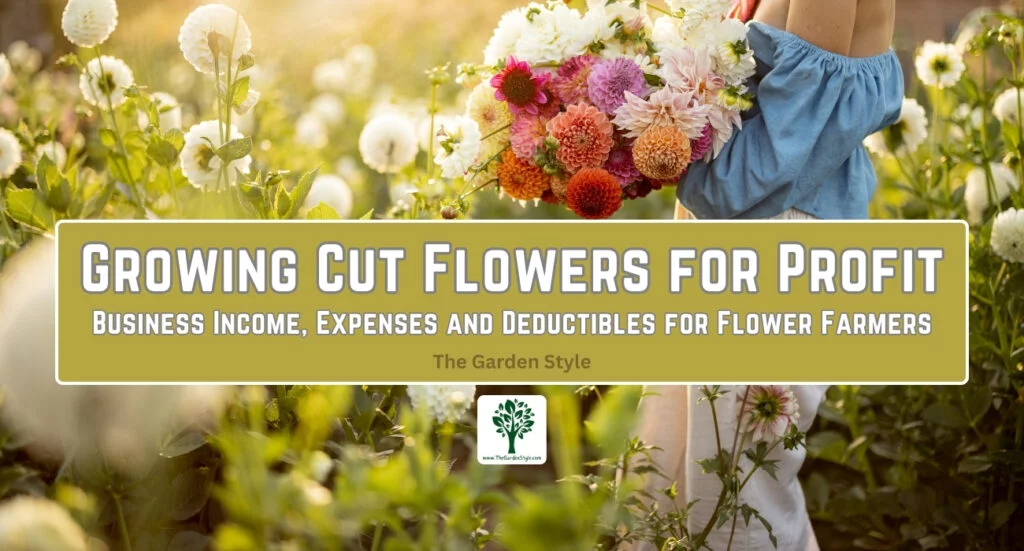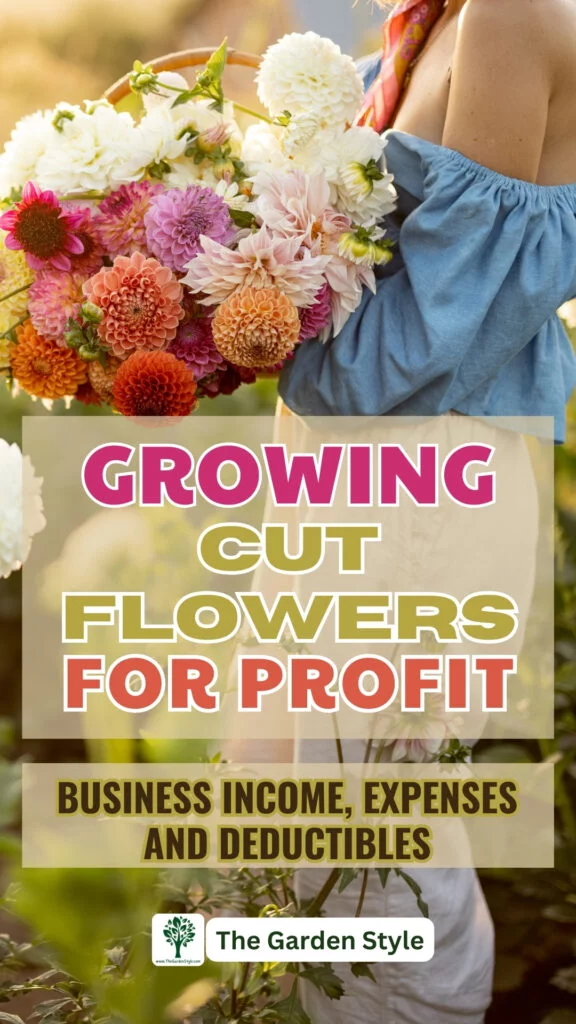If you’re interested in growing flowers for profit, it’s essential to understand the difference between a hobby and a business from a tax perspective. The USA Tax regulations form an intricate web of rules and exceptions. I write this article to bring some light to those who are starting to see if growing cut flowers for profit and having a flower farm (or backyard) could actually be a business. This article serves as a general guide, and you should always consult a tax professional if you are considering starting a flower farm business. Their expertise can help you navigate the complexities, ensuring you remain compliant while maximizing your financial prospects. I will do my best to address frequently asked questions and explore potential deductible expenses when growing cut flowers as a business.
Table of Contents
Growing Cut Flowers: Is A Business or A Hobby?

According to the IRS, a hobby is any activity that a person pursues for enjoyment with no intention of making a profit. If you sell flowers from your garden occasionally, that would be considered a hobby. Any income from a hobby must be reported on your tax return (Schedule 1, Form 1040, line 8), but you cannot deduct any expenses related to the hobby.
On the other hand, if you sell flowers with the intention of making a profit, you have a business. As a business owner, you’ll need to choose a legal structure such as a sole proprietorship, LLC, corporation, or partnership. You’ll also need to file the appropriate tax forms to report your business income and expenses.
Properly Reporting Business Income and Expenses: Choosing the Right Tax Forms for a Flower Farming or Growing Cut Flower for Profit (a Business)
As mentioned in the previous section, if you grow cut flowers in pots in your backyard or have a 2-acre flower farm, if you sell flowers, seeds, tubers, bouquets, dry flowers, tours, photos … (you name it), YOU HAVE A BUSINESS. Therefore, you must report your business income and expenses. (The good thing is that you can deduct a lot. Don’t miss the next section, as I explain the cut flower business deductibles.)
The form you should use to report business income and expenses depends on your business structure. I highly recommend considering your business structure before starting your cut flower business and consulting with a tax advisor. You may want to search for LLC benefits in some particular states, flower farming benefits in some states, etc.
- Sole Proprietor – Sch C or Sch F
- C-Corporation – Form 1120
- S- Corporation – Form 1120-S
- Partnership – Form 1065
- LLC Single-Member – Sch C or Sch F
- LLC C-Corporation – Form 1120
- LLC S-Corporation – Form 1120-S
- LLC Partnership – Form 1065
Understanding Tax Reporting for Farmers: Schedule F and Income from Farming
If your flower farming business is a sole proprietorship or a single-member LLC, you’ll file Schedule F (Profit or Loss From Farming) to report your income and expenses for the tax year. The IRS defines income from farming as “amounts you receive from cultivating, operating, or managing a farm for gain or profit, either as an owner or tenant.”
Maximizing Tax Deductions for Flower Farming Businesses: Essential Expenses and Start-Up Cost Benefits
As a flower farming business, you can deduct many expenses related to your operations. Some common deductible expenses for flower farmers include seeds, bulbs, soil, fertilizer, irrigation supplies, tools, packaging materials, labor costs, advertising, and more. You can also deduct a portion of your start-up costs (up to $5,000) in the year you begin an active trade or business.
You always want to make sure you claim all possible deductions for your business.
Additional Deductions Eligible When Growing Cut Flowers for Profit
There are other potential deductions when growing cut flowers for profit may be eligible for, depending on their specific circumstances. Here are some additional deductions that flower farmers might consider:
- Equipment and Machinery: Expenses related to purchasing, leasing, or maintaining farming equipment and machinery, such as tractors, tillers, harvesters, and other specialized tools, may be deductible.
- Repairs and Maintenance: Costs associated with repairing and maintaining farm buildings, greenhouses, equipment, and infrastructure can typically be deducted.
- Utilities: Expenses for utilities used in the operation of the farm, including electricity, water, heating, and cooling, may be deductible.
- Vehicle Expenses: If vehicles are used for farming purposes, such as transporting flowers to markets or delivering arrangements to customers, related expenses like fuel, maintenance, and depreciation may be deductible.
- Insurance Premiums: Premiums paid for business insurance policies, including property insurance, liability insurance, and crop insurance, are generally deductible.
- Professional Services: Fees paid for professional services such as accounting, legal advice, consulting, or hiring a farm manager may be deductible.
- Travel Expenses: Costs associated with business-related travel, including mileage, lodging, meals, and transportation, may be deductible if they are incurred for farm-related activities.
- Education and Training: Expenses for attending workshops, conferences, or courses related to flower farming or business management can often be deducted.
- Interest Expenses: Interest paid on loans used for farming operations, such as loans for purchasing land or equipment, may be deductible.
- Charitable Contributions: Donations made by the business to eligible charitable organizations may be deductible as business expenses.
Some of the Most Common Deductible Expenses When Growing Cut Flowers for Profit
Organized from A to Z, here are some of the most common deductible expenses when growing cut flowers on a flower farm. These include only the supplies needed for the garden and the process of starting seeds.
- ASCFG Membership Fee
- Bouquet Wraps
- Buckets
- Bulbs
- Burner
- Chicken Wire
- Cooler
- Cool-Bot
- Compost
- Corms
- Dirt
- Electric Extension Cords
- Fan (starting seeds)
- Fencing
- Floral Food
- Fertilizer
- Gloves
- Growing Lights
- Hand Tools
- Heating Mats
- Hoes
- Hoops
- Hose Nozzles
- Hoses
- Irrigation
- Labels
- Landscape Fabric
- Landscape Staples
- Measuring Wheel
- Mowers
It’s crucial to keep accurate records of all your business income and expenses throughout the year. Consult with a tax professional to ensure you’re taking advantage of all eligible deductions and filing the correct forms for your specific business structure.
Remember, tax laws can be complex, so it’s always advisable to seek professional guidance to ensure compliance and maximize your financial situation as a flower farming business owner.
Recommended Readings When Before Starting a Cut Flower Business
Before starting a cut flower business, we have some articles that I’m sure will help you.
- How to Start a Cut Flower Garden: Plan and Layout Explained for Beginners
- How to Write a Flower Farming Business Plan with a Template PDF Included
- Most Profitable Cut Flowers in the USA with prices
And, of course, The Garden Style has plenty of gardening guides to grow profitable cut flowers.
Pin it for later!

Additional Recommendations When Looking to Grow Cut Flowers for Profit
Here are some additional recommendations for people looking to grow cut flowers for profit:
1. Research your local market
- Understand the demand for locally grown cut flowers in your area by talking to florists, checking farmer’s markets, and observing what other local flower farms are doing.
- Identify potential customers like florists, grocery stores, restaurants, wedding planners, etc., and learn what varieties and quantities they need.
2. Start small and grow gradually
- Begin with a small plot of land and master the cultivation of a few popular cut flower varieties first.
- As you gain experience and build a customer base, then consider expanding production acreage.
3. Invest in season extension techniques
- Look into using high tunnels, low tunnels, row covers, etc., to get an early start and extend your growing season.
- This allows you to have flowers to sell for a longer period.
4. Focus on postharvest handling
- Proper harvesting, hydrating, grading, and bunching techniques are critical for quality cut flowers.
- Having a cool room/cooler and good postharvest supplies like floral preservatives is essential.
5. Diversify your product offerings
- In addition to fresh-cut flower bunches and bouquets, consider dried flowers, everlastings, wreath-making, etc.
- You can also offer on-farm experiences like U-picks and workshops.
6. Develop a strong marketing strategy
- Build a solid brand identity and online presence through a website and social media.
- Actively network and build relationships in the local flower community.
- Explore diverse sales channels like farmer’s markets, CSAs, and flower trucks/stands.
7. Join associations and continue learning
- Gain insights by joining associations like Specialty Cut Flower Growers associations and successful flower farms (just be sure they were successful and are not relocating the farm—that’s not a good business sign!).
- Attend workshops and conferences and subscribe to publications for cut flower growers.
8. Understand costs and pricing
- Carefully track all expenses related to labor, supplies, equipment, marketing, etc.
- Research the pricing of other local flower farms to be competitive while covering your costs.
For flower farmers and backyard cut flower growers, staying ahead of upcoming trends for summer and fall weddings in 2024 is crucial to ensure they can meet the demand for popular and unique blooms, enhance customer satisfaction, and maintain a competitive edge in the market. Gain a competitive edge by exploring the trending wedding market insights for 2024. Let’s see what is coming: Explore 55 stunning summer wedding bouquets trending for 2024!
The cut flower business requires passion, hard work, and business acumen, but it can be very rewarding for the right growers. Starting with a solid plan is vital.

